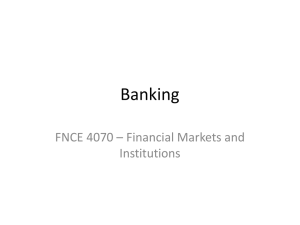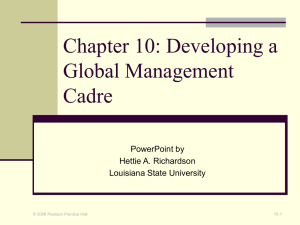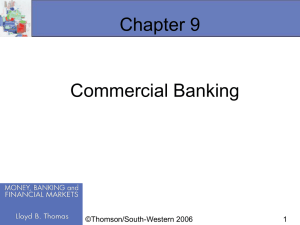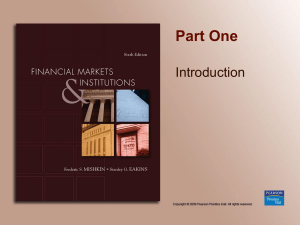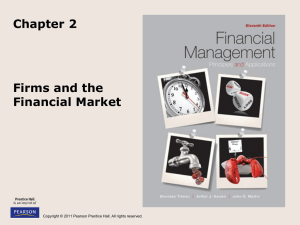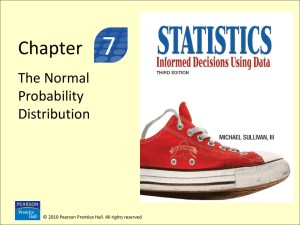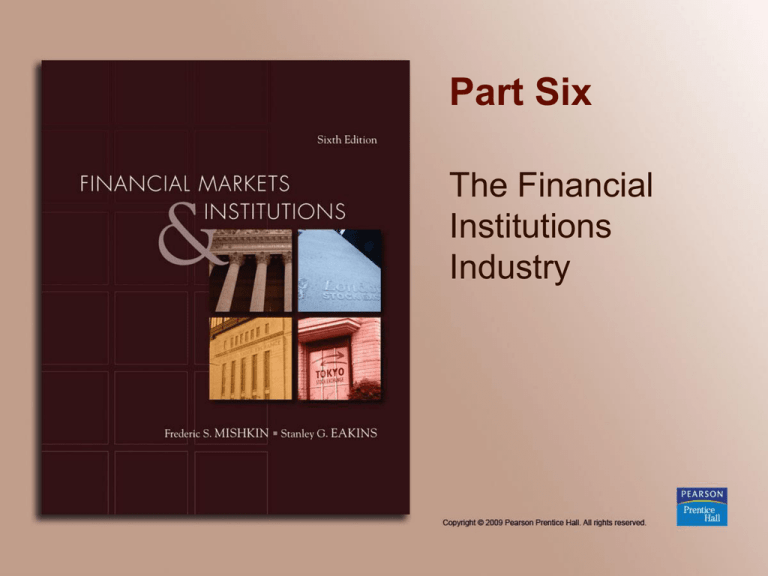
Part Six
The Financial
Institutions
Industry
Chapter 15
Banking and
the Management
of Financial
Institutions
PPT - Chapter (17)
Chapter Preview
• Banks play an important role in channeling
funds (about $6 trillion annually) to finance
productive investment opportunities.
• They provide loans to businesses, finance
college educations, and allow us to
purchase homes with mortgages.
Copyright © 2009 Pearson Prentice Hall. All rights reserved.
17-3
Chapter Preview
• In this chapter, we examine how banking is
conducted to earn the highest profits possible. In
the commercial banking setting, we look at loans,
balance sheet management, and income
determinants.
Topics include:
–
–
–
–
–
The Bank Balance Sheet
Basics of Banking
General Principles of Bank Management
Off-Balance Sheet Activities
Measuring Bank Performance
Copyright © 2009 Pearson Prentice Hall. All rights reserved.
17-4
The Bank Balance Sheet
• The Balance Sheet is a list of a bank’s
assets and liabilities
• Total assets = total liabilities + capital
Copyright © 2009 Pearson Prentice Hall. All rights reserved.
17-5
The Bank Balance Sheet
• A bank’s balance sheet lists sources of
bank funds (liabilities) and uses to which
they are put (assets)
• Banks invest these liabilities (sources) into
assets (uses) in order to create value for
their capital providers
Copyright © 2009 Pearson Prentice Hall. All rights reserved.
17-6
The Bank Balance Sheet
• The next slide shows the aggregate
balance sheet for all commercial banks as
of 2007. We will then step through each
item, discussing each in detail.
Copyright © 2009 Pearson Prentice Hall. All rights reserved.
17-7
The Bank Balance Sheet
Copyright © 2009 Pearson Prentice Hall. All rights reserved.
Flow of funds (tab down to commercial banks)
http://www.federalreserve.gov/releases/z1/
current/z1r-4.pdf
17-8
The Bank Balance Sheet:
Liabilities (a)
• Checkable Deposits: includes all accounts that
allow the owner (depositor) to write checks to
third parties; examples include non-interest
earning checking accounts (known as DDAs—
demand deposit accounts), interest earning
negotiable orders of withdrawal (NOW) accounts,
and money-market deposit accounts (MMDAs),
which typically pay the most interest among
checkable deposit accounts
Copyright © 2009 Pearson Prentice Hall. All rights reserved.
17-9
The Bank Balance Sheet:
Liabilities (a)
• Checkable deposits are a bank’s lowest
cost funds because depositors want safety
and liquidity and will accept a lesser
interest return from the bank in order to
achieve such attributes. They also make
up about 4% of bank liabilities.
Copyright © 2009 Pearson Prentice Hall. All rights reserved.
17-10
The Bank Balance Sheet:
Liabilities (b)
• Nontransaction Deposits: are the overall
primary source of bank liabilities (74%) and
are accounts from which the depositor
cannot write checks; examples include
savings accounts and time deposits (also
known as CDs or certificates of deposit)
Copyright © 2009 Pearson Prentice Hall. All rights reserved.
17-11
The Bank Balance Sheet:
Liabilities (b)
• Nontransaction deposits are generally a
bank’s highest cost funds because banks
want deposits which are more stable and
predictable and will pay more to the
depositors (funds suppliers) in order to
achieve such attributes.
Copyright © 2009 Pearson Prentice Hall. All rights reserved.
17-12
The Bank Balance Sheet:
Liabilities (c)
• Borrowings: banks obtain funds by borrowing
from the Federal Reserve System, other banks,
and corporations; these borrowings are called:
discount loans/advances (from the Fed), fed
funds (from other banks), interbank offshore
dollar deposits (from other banks), repurchase
agreements (a.k.a., “repos” from other banks and
companies), commercial paper and notes (from
companies and institutional investors)
Copyright © 2009 Pearson Prentice Hall. All rights reserved.
17-13
The Bank Balance Sheet:
Liabilities (c)
• Certain borrowings can be more volatile
than other liabilities, depending on
market conditions. They currently make up
about 12% of bank liabilities, but have been
as high as 26% (2004) and as low as 2%
(1960) in recent history.
Copyright © 2009 Pearson Prentice Hall. All rights reserved.
17-14
The Bank Balance Sheet:
Liabilities (d)
• Bank Capital: is the source of funds
supplied by the bank owners, either directly
through purchase of ownership shares or
indirectly through retention of earnings
(retained earnings being the portion of
funds which are earned as profits but not
paid out as ownership dividends). This is
about 8% of assets.
Copyright © 2009 Pearson Prentice Hall. All rights reserved.
17-15
The Bank Balance Sheet:
Liabilities (d)
• Since assets minus liabilities equals capital,
capital is seen as protecting the liability
suppliers from asset devaluations or writeoffs (capital is also called the balance
sheet’s “shock absorber,” thus capital levels
are important).
Copyright © 2009 Pearson Prentice Hall. All rights reserved.
17-16
The Bank Balance Sheet:
Assets (a)
• Reserves: funds held in account with the
Fed (vault cash as well). Required
reserves represent what is required by law
under current required reserve ratios.
Any reserves beyond this area called
excess reserves.
Copyright © 2009 Pearson Prentice Hall. All rights reserved.
17-17
The Bank Balance Sheet:
Assets (a)
• Cash items in Process of Collection:
checks deposited at a bank, but where the
funds have not yet been transferred from
the other bank.
• Deposits at Other Banks: usually deposits
from small banks at larger banks (referred
to as correspondent banking)
Copyright © 2009 Pearson Prentice Hall. All rights reserved.
17-18
The Bank Balance Sheet:
Assets (a)
• Reserves, Cash items in Process of
Collection, and Deposits at Other Banks
are collectively referred to as Cash Items
in our balance sheet, and account for 2% of
assets.
Copyright © 2009 Pearson Prentice Hall. All rights reserved.
17-19
The Bank Balance Sheet:
Assets (b)
• Securities: these are either U.S.
government/agency debt, municipal debt,
and other (non-equity) securities. These
make-up about 17% of assets. Short-term
Treasury debt is often referred to as
secondary reserves because of its high
liquidity.
Copyright © 2009 Pearson Prentice Hall. All rights reserved.
17-20
The Bank Balance Sheet:
Assets (c)
• Loans: representing 74% of assets, these
are a bank’s income-earning assets, such
as business loans, auto loans, and
mortgages. These are generally not very
liquid. Most banks tend to specialize in
either consumer loans or business loans,
and even take that as far as loans to
specific groups (such as a particular
industry).
Copyright © 2009 Pearson Prentice Hall. All rights reserved.
17-21
The Bank Balance Sheet:
Assets (d)
• Other Assets: bank buildings, computer
systems, and other equipment.
Copyright © 2009 Pearson Prentice Hall. All rights reserved.
17-22
Basics of Banking
Before we explore the main role of banks—
that is, asset transformation—it is helpful to
understand some of the simple accounting
associated with the process of banking.
But think beyond the debits/credit – and try
to see that banks engage in asset
transformation.
Copyright © 2009 Pearson Prentice Hall. All rights reserved.
17-23
Basics of Banking
Asset transformation is, for example,
when a bank takes your savings deposits
and uses the funds to make, say, a
mortgage loan. Banks tend to “borrow
short and lend long” (in terms of maturity).
Copyright © 2009 Pearson Prentice Hall. All rights reserved.
17-24
Basics of Banking
• T-account Analysis:
– Deposit of $100 cash into First National Bank
First National Bank
Assets
Vault cash
+$100
Copyright © 2009 Pearson Prentice Hall. All rights reserved.
Liabili ties
Checkable
deposits
+$100
17-25
Basics of Banking
• Deposit of $100 check
First National Bank
Assets
Cash items in
process of
collection
Liabili ties
+$100
First National Bank
Assets
Reserves
+$100
Liabilities
Deposits
+$100
Checkable
deposits
+$100
Second National Bank
Assets
Reserves
-$100
Liabili ties
Deposits
-$100
Conclusion: When bank receives deposits, reserves by equal
amount; when bank loses deposits, reserves by equal amount
Copyright © 2009 Pearson Prentice Hall. All rights reserved.
17-26
Basics of Banking
This simple analysis gets more complicated
when we add bank regulations to the
picture. For example, if we return to the
$100 deposit, recall that banks must
maintain reserves, or vault cash. This
changes how the $100 deposit is recorded.
Copyright © 2009 Pearson Prentice Hall. All rights reserved.
17-27
Basics of Banking
• T-account Analysis:
– Deposit of $100 cash into First National Bank
First National Bank
Assets
Required reserves +$10
Excess reserves
+$90
Copyright © 2009 Pearson Prentice Hall. All rights reserved.
Liabilities
Checkable
deposits
+$100
17-28
Basics of Banking
As we can see, $10 of the deposit must
remain with the bank to meeting federal
regulations. Now, the bank is free to work
with the $90 in its asset transformation
functions. In this case, the bank loans the
$90 to its customers.
Copyright © 2009 Pearson Prentice Hall. All rights reserved.
17-29
Basics of Banking
• T-account Analysis:
– Deposit of $100 cash into First National Bank
First National Bank
Assets
Required reserves +$10
Loans
+$90
Copyright © 2009 Pearson Prentice Hall. All rights reserved.
Liabilities
Checkable
deposits
+$100
17-30
General Principles
of Bank Management
Now let’s look at how a bank manages its assets
and liabilities. The bank has four primary
concerns:
1. Liquidity management
2. Asset management
– Managing credit risk
– Managing interest-rate risk
3. Liability management
4. Managing capital adequacy
Copyright © 2009 Pearson Prentice Hall. All rights reserved.
17-31
General Principles
of Bank Management
Although we will focus on these ideas,
banks must also manage credit risk and
interest-rate risk. An in-depth discussion
of these topics will be presented in
Chapter 24.
Copyright © 2009 Pearson Prentice Hall. All rights reserved.
17-32
Principles of Bank Management
Liquidity Ma nagement
Reserves requirement = 10%, Excess reserves = $10 million
Assets
Liabili ties
Reserves
$20 million
Deposits
Loans
$80 million
Bank Capit al
Securiti es
$10 million
Copyright © 2009 Pearson Prentice Hall. All rights reserved.
$100 million
$10 million
17-33
Principles of Bank Management
Deposit outflow of $10 million
Assets
Liabili ties
Reserves
$10 million
Deposits
$90 million
Loans
$80 million
Bank Capit al
$10 million
Securiti es
$10 million
• With 10% reserve requirement, bank still has
excess reserves of $1 million: no changes
needed in balance sheet
Copyright © 2009 Pearson Prentice Hall. All rights reserved.
17-34
Liquidity Management
No excess reserves
Assets
Liabili ties
Reserves
$10 million
Deposits
$100 million
Loans
$90 million
Bank Capit al
Securiti es
$10 million
$10 million
Deposit outflow of $10 million
Assets
Reserves
Liabili ties
$0 million
Loans
$80 million
Securiti es
$10 million
Deposits
$90 million
Bank Capit al
$10 million
• With 10% reserve requirement, bank has $9 million
reserve shortfall
Copyright © 2009 Pearson Prentice Hall. All rights reserved.
17-35
Liquidity Management
1. Borrow from other banks o r corporations
Assets
Liabili ties
Reserves
Loans
$9 million
$90 million
Deposits
Borrowings
Securiti es
$10 million
Bank Capit al
$100 million
$9 million
$10 million
2. Sell securities
Assets
Liabili ties
Reserves
Loans
$9 million
$90 million
Securiti es
$1 million
Copyright © 2009 Pearson Prentice Hall. All rights reserved.
Deposits
Bank Capit al
$90 million
$10 million
17-36
Liquidity Management
3. Borrow from Fed
Assets
Liabilities
Reserves
Loans
$9 million Deposits
$90 million Discount Loans
$90 million
$9 million
Securities
$10 million Bank Capital
$10 million
4. Call in or sell off loans
Assets
Liabili ties
Reserves
Loans
$9 million
$81 million
Securiti es
$10 million
Deposits
Bank Capit al
$90 million
$10 million
• Conclusion: Excess reserves are insurance against
above 4 costs from deposit outflows
Copyright © 2009 Pearson Prentice Hall. All rights reserved.
17-37
Asset Management
• Asset Management: the attempt to earn the
highest possible return on assets while
minimizing the risk.
1. Get borrowers with low default risk, paying
high interest rates
2. Buy securities with high return, low risk
3. Diversify
4. Manage liquidity
Copyright © 2009 Pearson Prentice Hall. All rights reserved.
17-38
Liability Management
• Liability Management: managing the
source of funds, from deposits, to CDs,
to other debt.
1. Important since 1960s
2. No longer primarily depend on deposits
3. When see loan opportunities, borrow or issue
CDs to acquire funds
Copyright © 2009 Pearson Prentice Hall. All rights reserved.
17-39
Liability Management
• It’s important to understand that banks now
manage both sides of the balance sheet
together, whereas it was more separate in
the past. Indeed, most banks now manage
this via the asset-liability management
(ALM) committee.
• This explains the increased use of CDs and
loans over checkable deposits in recent
decades.
Copyright © 2009 Pearson Prentice Hall. All rights reserved.
17-40
Capital Adequacy Management
1. Bank capital is a cushion that prevents bank failure.
For example, consider these two banks:
High Capital Bank
Assets
Reserves
Loans
Liabilities
$10 million Deposits
$90 million Bank Capital
$90 million
$10 million
Low Capital Bank
Assets
Reserves
Loans
Liabilities
$10 million Deposits
$90 million Bank Capital
Copyright © 2009 Pearson Prentice Hall. All rights reserved.
$96 million
$4 million
17-41
Capital Adequacy Management
What happens if these banks make loans
or invest in securities (say, subprime
mortgage loans, for example) that end up
losing money? Let’s assume both banks
lose $5 million from bad loans.
Copyright © 2009 Pearson Prentice Hall. All rights reserved.
17-42
Capital Adequacy Management
Impact of $5 million loan loss
High Capital Bank
Assets
Reserves
Loans
Liabilities
$10 million Deposits
$85 million Bank Capital
$90 million
$5 million
Low Capital Bank
Assets
Reserves
Loans
Liabilities
$10 million Deposits
$85 million Bank Capital
$96 million
-$1 million
Conclusion: A bank maintains reserves to lessen the
chance that it will become insolvent.
Copyright © 2009 Pearson Prentice Hall. All rights reserved.
17-43
Capital Adequacy Management
So, why don’t banks hold want to hold a lot of
capital??
2. Higher is bank capital, lower is return on equity
–
ROA = Net Profits/Assets
–
ROE = Net Profits/Equity Capital
–
EM = Assets/Equity Capital
–
ROE = ROA EM
–
Capital , EM , ROE
Copyright © 2009 Pearson Prentice Hall. All rights reserved.
17-44
Capital Adequacy Management
3. Tradeoff between safety (high capital) and
ROE
4. Banks also hold capital to meet capital
requirements (more on this in Chapter 20).
Copyright © 2009 Pearson Prentice Hall. All rights reserved.
17-45
The Practicing Manager:
Strategies for Managing Capital: what
should a bank manager do if she feels the
bank is holding too much capital?
•
Sell or retire stock
•
Increase dividends to reduce retained
earnings
•
Increase asset growth via debt (like CDs)
Copyright © 2009 Pearson Prentice Hall. All rights reserved.
17-46
The Practicing Manager:
Reversing these strategies will help a
manager if she feels the bank is holding
too little capital?
•
Issue stock
•
Decrease dividends to increase retained
earnings
•
Slow asset growth (retire debt)
Copyright © 2009 Pearson Prentice Hall. All rights reserved.
17-47
The Capital Crunch and the
Credit Crunch in the early 1990s
Did the capital crunch cause the credit
crunch in the early 1990s?
– In 1990 and 1991 credit growth slowed to an
extremely low pace
– Our analysis suggests that a capital crunch
was a likely cause. Loan losses in the late 80s
and an increase in capital requirements
immediately preceded this period.
Copyright © 2009 Pearson Prentice Hall. All rights reserved.
17-48
The Capital Crunch and the
Credit Crunch in the early 1990s
Did the capital crunch cause the credit
crunch in the early 1990s?
– Banks were forced to either (1) raise new
capital or (2) reduce lending. Guess which
route they chose?
Copyright © 2009 Pearson Prentice Hall. All rights reserved.
17-49
Off-Balance-Sheet Activities
1.
2.
Loan sales (secondary loan participation)
Fee income from
–
–
–
–
3.
Foreign exchange trades for customers
Servicing mortgage-backed securities
Guarantees of debt
Backup lines of credit
Trading Activities and Risk Management Techniques
1.
2.
3.
•
Financial futures and options
Foreign exchange trading
Interest rate swaps
All these activities involve risk and potential
conflicts
Copyright © 2009 Pearson Prentice Hall. All rights reserved.
17-50
Rouge Traders
To highlight the problems that some of
these off-balance sheet activities generate,
we will briefly look at two incidences with
devastating results.
Barings: Nick Leeson engaged in
speculative trades on the Nikkea, and
personally generated $1.3 billion in losses
over a 3-year period. Barings had to close!
Copyright © 2009 Pearson Prentice Hall. All rights reserved.
17-51
Rouge Traders
Daiwa Bank: Toshihide Iguchi racked up
$1.1 billion in losses in trading. When he
fessed-up, the bank decided to hide this
from regulators. The bank was eventually
fined $340 million and barred from U.S.
operations.
Copyright © 2009 Pearson Prentice Hall. All rights reserved.
17-52
Measuring Bank Performance
Much like any business, measuring bank
performance requires a look at the income
statement. For banks, this is separated into
three parts:
– Operating Income
– Operating Expenses
– Net Operating Income
Note how this is different from, say, a
manufacturing firm’s income statement.
Copyright © 2009 Pearson Prentice Hall. All rights reserved.
17-53
Banks' Income
Statement
Measuring Bank Performance
As, much like any firm, ratio analysis is
useful to measure performance and
compare performance among banks. The
following slide shows both calculations and
historical averages for key bank
performance measures.
Copyright © 2009 Pearson Prentice Hall. All rights reserved.
17-55
Recent Trends
in Bank Performance Measures
• ROA = Net Profits/
Assets
• ROE = Net Profits/
Equity Capital
• NIM = [Interest Income Interest Expenses]/
Assets
Chapter Summary
• The Bank Balance Sheet: we reviewed the
basic assets, liabilities, and bank capital
that make up the balance sheet
• Basics of Banking: we examined the
accounting entries for a series of simple
bank transactions
Copyright © 2009 Pearson Prentice Hall. All rights reserved.
17-57
Chapter Summary (cont.)
• General Principles of Bank Management:
we discussed the roles of liability, reserves,
asset, and capital adequacy management
for a bank
• Off-Balance Sheet Activities: we briefly
reviewed some of the (risky) activities that
banks engage in that don’t appear on the
balance sheet or income statement
Copyright © 2009 Pearson Prentice Hall. All rights reserved.
17-58
Chapter Summary (cont.)
• Measuring Bank Performance: we reviewed
the income statement for a banking
organization and key ratios commonly used
for measuring and comparing bank
performance
Copyright © 2009 Pearson Prentice Hall. All rights reserved.
17-59


